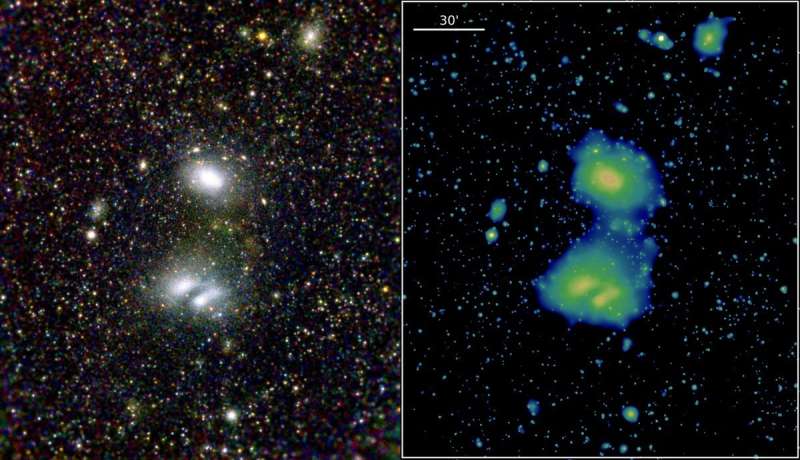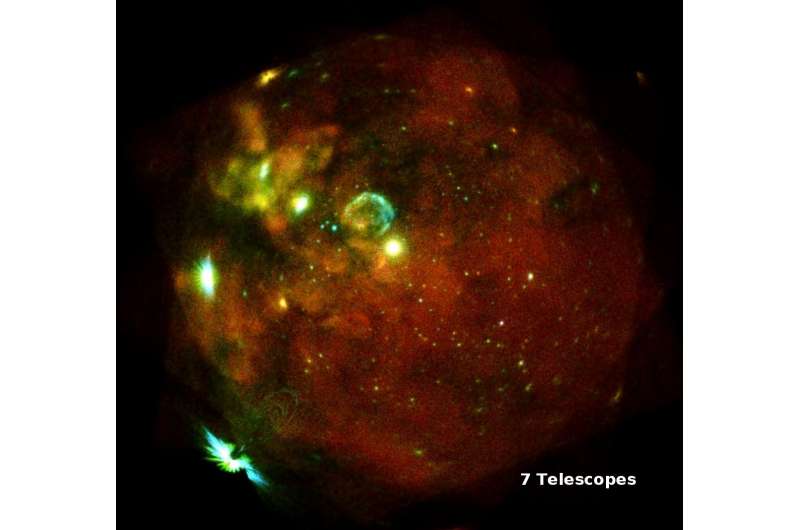Far-away nebulae: These two eROSITA images show the two interacting galaxy clusters A3391 and A3395, highlighting eROSITAs superb view of the distant Universe. They were observed in series of exposures with all seven eROSITA telescope modules an October 17 and 18, 2019. The individual images were subjected to different analysis techniques, and then coloured in different schemes to highlight the different structures. In the left-hand image, the red, green and blue colours refer to the three different energy bands of eROSITA. One clearly sees the two clusters as nebulous structures, which shine brightly in X-rays due to the presence of extremely hot gas (millions of degrees) in the space between galaxies. The image on the right highlights the “bridge” between the two clusters, confirming the suspicion that these two huge structures actually interact dynamically. The eROSITA observations also show hundreds of point-like sources, signposting either distant supermassive black holes or hot stars in the Milky Way. Credit: T. Reiprich (Univ. Bonn), M. Ramos-Ceja (MPE), F. Pacaud (Univ. Bonn), D. Eckert (Univ. Geneva), J. Sanders (MPE), N. Ota (Univ. Bonn), E. Bulbul (MPE), V. Ghirardini (MPE), MPE/IKI
Astronomers are excited: The first images by the eROSITA telescope launched in July reveal an impressive performance. After an extended commissioning phase, all seven X-ray telescope modules with their custom-designed CCD cameras have been observing the sky simultaneously since 13 October. The first composite images show our neighboring galaxy, the Large Magellanic Cloud, and two interacting clusters of galaxies at a distance of about 800 million light years in remarkable detail.
"Now we can start reaping the fruits of more than ten years of work. We are all impressed by the beautiful first images from our telescope," enthuses Peter Predehl, Principal Investigator of eROSITA. "To meet our science goals we needed enough sensitivity to detect the most distant clusters of galaxies in the X-ray universe over the whole sky, and resolve them spatially. These First Light images show that we can do exactly that, but we can go a lot further. The CCD cameras are state-of the art with superb spectral and timing resolution. The potential for new discoveries is immense." The eROSITA first light images were obtained in a series of exposures of all seven telescope modules with a combined integration time of about one day for both the Large Magellanic Cloud (LMC), our neighboring galaxy, and the A3391/3395 system of interacting clusters of galaxies at a distance of about 800 Million light-years.
In our neighboring galaxy, the LMC, eROSITA not only shows the distribution of the LMCs diffuse hot gas, but also some remarkable details, such as supernova remnants like SN1987A. The eROSITA image now confirms that this source is becoming fainter, as the shock wave produced in by the stellar explosion in 1987 propagates through the interstellar medium. In addition to a host of other hot objects in the LMC itself, eROSITA also reveals a number of foreground stars from our own Milky Way galaxy as well as distant active galactic nuclei, whose radiation pierces the diffuse emission of the hot gas in the LMC.
"X-rays give us a unique view of the universe," explains Kirpal Nandra, director of high energy astrophysics at MPE. "Looking at an apparently normal star, we might see an orbiting white dwarf or neutron star in the process of devouring its companion. Visible light shows the structure of a galaxy traced by its stars, but the X-rays are dominated by supermassive black holes growing at their centers. And where we see clusters of galaxies with optical telescopes, X-rays reveal the huge reservoirs of gas filling the space between them and tracing out the dark matter structure of the universe. With its performance demonstrated, we now know that eROSITA will lead to a breakthrough in our understanding of the evolution of the energetic universe."
Neighbour in space: This image shows our neighbouring galaxy, the Large Magellanic Cloud, observed in series of exposures with all seven eROSITA telescope modules on October 18 and 19, 2019. The diffuse emission originates from the hot gas between the stars. The nebulous structures in the image are mainly supernova remnants, i.e. stellar atmospheres expelled in huge explosions at the end of a massive stars’ lifetime. The most prominent one, SN1987A, is seen close to the centre as an almost circular, bluish cloud. A host of other sources in the LMC itself include accreting binary stars or stellar clusters with very massive young stars (up to 100 solar masses and more). There are also a number of point sources, either foreground stars from our home galaxy or distant active galactic nuclei. Credit: F. Haberl, M. Freyberg and C. Maitra, MPE/IKI
Reaching further out into the universe, the eROSITA image of the A3391/3395 system of interacting clusters of galaxies highlights the dynamical processes which lead to the formation of gigantic structures in the universe. The clusters, appearing as large, elliptical nebulae in the eROSITA images, span tens of millions of light-years across, and contain thousands of galaxies each. Clusters of galaxies are one of the main science targets for eROSITA; astronomers expect to find some 100,000 X-ray emitting galaxy clusters as well as several million active black holes in the centers of galaxies during its four-year, all-sky survey in the soft and hard X-ray bands.
"This is a dream come true. We now know that eROSITA can deliver on its promise and create a map of the whole X-ray sky with unprecedented depth and detail," confirms Andrea Merloni, eROSITA Project Scientist. "The legacy value will be enormous. Beside the beautiful images like the ones we're showing today, catalogs of millions of exotic celestial objects such as black holes, galaxy clusters, neutron stars, supernovae and active stars will be used by astronomers for years to come."
Launched on 13 July 2019 as part of the Russian-German Spektrum-Roentgen-Gamma (SRG) space mission, which also includes the Russian ART-XC telescope, eROSITA completed its 1.5 million kilometer journey to the second Lagrange point (L2) of the Earth-Sun-system in late September and has now—100 days after launch—entered an orbit around L2. The commissioning phase of the telescope was officially completed on 13 October. While the scientific performance of the system is outstanding, this first phase was not problem-free.
"The commissioning phase lasted longer than expected, after we found some anomalies in the electronic controls of the cameras," explains Peter Predehl. "But teasing out these problems is exactly why we have such a phase. After a careful analysis we determined that the issues are not critical. We're still working on them, but in the meantime the program can go forward normally." The telescope has now entered the so-called calibration and performance verification (CalPV) phase, during which astronomical observations are carried out to better understand the instrument and verify its full potential to meet the scientific requirements. At the end of the CalPV phase, after a final review by the operations team, SRG and eROSITA will enter into its prime phase, the four year all-sky X-ray survey.
Provided by Max Planck Society

























